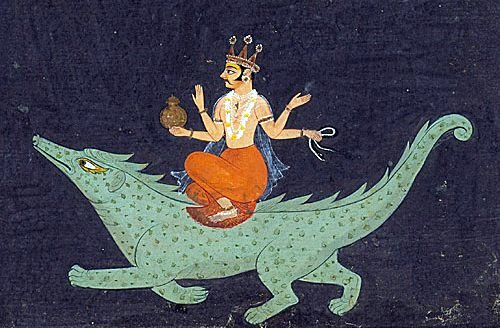
Hail to thee, O doer of fair deeds,
Come and assist us in our needs.
As a cow comes its calf to feed,
So accept our extract of Soma reed.
For Soma you have attraction,
As felicity rich’s kine donation.
Let's have your generosity chaste,
Do not consider us lying waste.
Come this way and make haste,
Go to Indra, his power prostrate.
Wise and unvanquished he stands,
In singing skill he all outstands.
Bother not, who condemn and say:
Get lost, you take some other way,
You serve Indra, none else you pray;
Those who praise him hold the sway.
Weather God, you miracles perform,
Your blessings tide over the storm.
The swiftest among the swift,
Grace our sacrifices and lift,
All friends winged joys gift,
Satakratu, Vrtra* slay split,
You help the warriors in the fray,
Come, taste our drink, we pray.
O, Satkratu, you are powerful in fight,
We gird up and support you in spirit right.
Indra is the source of wealth and blight,
Win his favor, seek wealth, him don't fight.
Praise him, from whom the nectar flows,
To his pleasure, let your songs compose.
*Inspired by Rig Veda Hymn 1: 4
*In the early Vedic religion, Vritra was an Asura and also a serpent or dragon, the personification of drought and enemy of Indra. Vritra was also known in the Vedas as Ahi ('snake') , and he is said to have had three heads. The myth involving Vritra evolved over time as Indra's prominence at the head of the Pantheon faded and the Brahmins sought to glorify Vishnu. According to the Rig Veda, Vritra kept the waters of the world captive until he was killed by Indra, who destroyed all the ninety-nine fortresses of Vritra (although the fortresses are sometimes attributed to Sambara) before liberating the imprisoned rivers. The combat began soon after Indra was born, and he had drunk a large volume of Soma at Tvashtri's house to empower him before facing Vritra. Tvashtri fashioned the thunderbolt (Vajrayudha) for Indra, and Vishnu, when asked to do so by Indra, made space for the battle by taking the three great strides for which he became famous. Vritra broke Indra's two jaws during the battle, but was then thrown down by the latter and, in falling, crushed the fortresses that had already been shattered. For this feat, Indra became known as Vritrahan 'slayer of Vritra' and also as 'slayer of the first-born of dragons'. Vritra's mother, Danu (who was also the mother of the Danava race of Asuras) , was then attacked and defeated by Indra with his thunderbolt In one of the versions of the story, three Asuras - Varuna, Soma and Agni - were coaxed by Indra into aiding him in the fight against Vritra whereas before they had been on the side of the demon (whom they called 'Father') . Some modern Indian geologists interpret the Vedic story as a description of the breakup of glaciers. B.P. Radhakrishna writes: 'Geological record indicates that during Late Pleistocene glaciation, the waters of the Himalaya were frozen and that in place of rivers there were only glaciers, masses of solid ice. As and when the climate became warmer, the glaciers began to break up and the frozen water held by them surged forth in great floods, inundating the alluvial plains in front of the mountains.... no wonder the early inhabitants of the plains burst into song praising Lord Indra for breaking up the glaciers and releasing water which flowed out in seven mighty channels (Sapta Sindhu) . The analogy of a slowly moving serpent (Ahi) for describing the Himalayan glacier is most appropriate'.
|
|